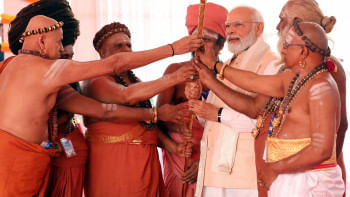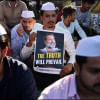The rise of the Ambani brand

A few nights ago, I shared a picture of Nita Ambani, billionaire philanthropist, art connoisseur and the wife of Asia's richest man, Mukesh Ambani, donning an exquisite piece of jewellery around her neck. The massive emerald-encrusted necklace, stuck out like a sore—need I say, almost vulgar—sight, but it was the caption that caught my attention, which read, "Nita Ambani casually wearing a country's GDP around her neck."
The Ambani family is not particularly known for their "poverty peacocking" or practising "quiet luxury" like many other uber-rich individuals, particularly from the West. They, in fact, do not hesitate to make a nauseating display of their luxurious flair at every opportunity they get—let's not forget the $100 million pre-wedding celebrations of Isha Ambani in 2018 or the star-studded grand opening of Nita Mukesh Ambani Cultural Centre last year. The concept of a billionaire, in itself, has emerged thanks to a flawed system. That money maths does not add up without throwing in some degree of political lobbying, or exploitation of the working class or wide failure of economic policies, into the mixture. However, being a billionaire as rich as an Ambani in a nation like India is fodder for dystopian storytelling.
At the turn of this month, the quiet city of Jamnagar in Gujarat witnessed an explosive and glitzy three-day pre-wedding celebration of the youngest son of the Ambani family. Even after all that razzmatazz, he is yet to tie the knot. The alleged $120 million bash was a mass spectacle of the upper-class solidarity that had tech tycoons and global politicians participate in full opulence, Bollywood celebrities temporarily demoted to background dancers, the domestic airport of Jamnagar temporarily promoted to international status, and a nine-page dress code that made even Mark Zuckerberg go for the bling. It also made Rihanna come out of her retirement for a two-hour private concert, and this is where things start to get a little grotesque.
Yes, they are involved in large-scale philanthropy, job creation and tax contribution, but what about their manipulation of the political system, media acquisition, favourable contracts and secured lands that come at extremely low prices, exemptions from loan repayments and chronic exploitation? To what extent is this wealth really theirs to splurge then? To what extent should they be allowed to become representatives of India's image, when they have removed themselves so far from reality?
The pre-wedding festivities clashed with the second wave of farmers' protest in India that started in 2021, after a legislation was passed that permitted private companies to purchase directly from farmers, which would have deterred farmers from getting the "minimum support price." It was the same protest that Rihanna had tweeted about in the same year saying, "Why aren't we talking about this?" The same protest where the name of Mukesh Ambani (and Gautam Adani) got dragged into with farmers claiming that the law was enacted to give access to said billionaires into the agricultural industry. Fast forward to three years, Rihanna arrives to perform in the pre-wedding extravaganza of the youngest scion of the same man who was being protested against in 2021, and it also coincides impeccably with the same continued protest. As expected, despite being physically present in India this time, she had no comment to make. Now, the optics of this whole situation can be deduced to be a psyop tactic or a strategic publicity move, or it could be just a mere coincidence—albeit a distasteful one.
But even after dismissing all that as a little conspiracy, the picture that the Ambanis are trying to establish of a rich India on the global stage, based on their affluence and corporate hegemony, with the idea here being, "Brand Ambani is the force multiplier for Brand Bharat," is not only a false rhetoric but also brazenly dangerous. Indian social and national media channels fought to get a piece of this sensational slice, while forgetting about other grave issues plaguing the country. It is also quite evident that such rhetoric is being fully endorsed by BJP supporters as they proudly promote the Ambani shebang as a symbol of India's strength, and even as a champion of Hindutva. This corporate-political nexus, which has been fortified since the rise of the Modi government, has established the ways of crony capitalism in India that keeps expanding the vast gulf between the filthy rich and working class like some mindless machine. The pandemic, especially, was a testament to that as "the combined fortunes of Ambani and Adani swelled by almost $41 billion, even as millions of Indians lost their jobs to the pandemic that pummelled the $2.9 trillion economy," according to an analysis. The greedy politician and the greedy businessman mutually depend on each other. The politician relies on the businessman for funds and the businessman depends on the politician for favourable deals. This cycle sustains the status quo while the rest of the people remain as just cogs in the machine.
The multi-million-dollar celebrations took place in an expansive 750-acre gated compound, right beside one of the poorest slums in India. The two parallel universes co-existing and the thick boundary between them is strangely reminiscent of the wall that was resurrected in Ahmedabad in 2020 to hide slumps as Donald Trump drove by. It also reminds one of the family's residence in Mumbai, Antilia, named after a mythical island. The 27-storey mammoth residential skyscraper menacingly towers over Mumbai slum dwellers, yet is so mockingly out of the grasp of even their wildest imaginations, just like its name. "This is a gated community in the sky," as aptly quoted by author Gyan Prakash. According to the World Bank, "almost half of the 1.4 billion people in India live below the median poverty line of $3.65 a day." Many activists have denounced such monstrous displays of luxury, calling this "an affront to the country's poor." And yet, as uncomfortable as all of this is, many would argue that the Ambanis are free to spend their money as they deem fit.
But, then again, with great wealth, should there not be great scrutiny and accountability? Yes, they are involved in large-scale philanthropy, job creation and tax contribution, but what about their manipulation of the political system, media acquisition, favourable contracts and secured lands that come at extremely low prices, exemptions from loan repayments and chronic exploitation? To what extent is this wealth really theirs to splurge then? To what extent should they be allowed to become representatives of India's image, when they have removed themselves so far from reality? As we ponder over these questions with condemnation, astonishment and even some degree of envy, the city of Jamnagar has already gone back to its slow beating pulse, with its inhabitants, perhaps, left feeling the poorest they have in all their lives.
Iqra L Qamari is a writer and freelance consultant. She can be reached at [email protected]
Views expressed in this article are the author's own.
Follow The Daily Star Opinion on Facebook for the latest opinions, commentaries and analyses by experts and professionals. To contribute your article or letter to The Daily Star Opinion, see our guidelines for submission.

 For all latest news, follow The Daily Star's Google News channel.
For all latest news, follow The Daily Star's Google News channel. 









Comments